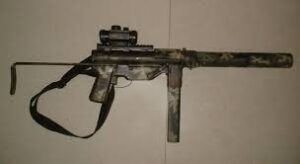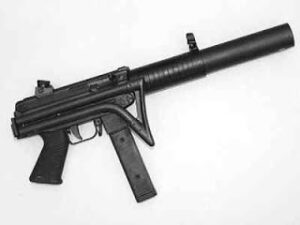Following my recent look at covert and James Bond firearms, I thought a look at armament for more “overt” special operations might be instructive.
In addition to special forces, this includes the reconnaissance sections of more conventional units and hostage rescue units such as SWAT.
If our TV screens are to be believed, special forces always favour unsuppressed MP5s, which will seldom be fired in bursts of less than ten rounds. Some MP5s used as props have probably logged more screen time than Richard Jaeckel!
There is no single “best” weapons for such operations so I will limit this post to the subject of suppressed weapons.
There are a number of reasons why suppressed weapons might be used.
The obvious one is to avoid unwelcome attention. As well as the military advantages of this property, it is also welcome for applications such as pest control.
In confined spaces, gunfire can be deafening and disorientating, which is a reason to favour suppressed weapons for overt CQB operations such as SWAT assaults.
Suppressors also protect the hearing of shooters (and that of their dogs) so can be beneficial in situations where more conventional hearing protection is impractical.
I recently read a statement that some suppressors make shooting in volatile atmospheres such as drug labs less hazardous.
Below is a British weapon known as a “De Lisle Carbine”.
These were built from a number of existing constructions. The action is from an SMLE, the magazine from a Colt 1911, the barrel from a Thompson SMG and the sights from a Lancaster machine carbine. The stock of the folding variant looks like that of a Patchett/Sterling, a weapon being developed in the same factory at the same time.


Allegedly, the loudest noise when firing the De Lisle was the striker hitting the cap!
The bolt handle included a rubber pad on the underside to muffle the metallic click of operation.
Operating the bolt was the loudest part of operating the De Lisle, but being a manual action the user could at least choose to do this when they thought it most expedient.
Unlike many of its contemporaries, the De Lisle uses the .45 ACP round and is effective to three or four hundred yards.
The De Lisle was used in the latter half of World War Two and the Malaya Emergency. It may have been used in Korea, Northern Ireland and later conflicts.



The De Lisle was an excellent weapon for dispatching sentries at relatively long ranges.
It was not so useful if you needed to quickly neutralize a guardroom full of enemies.
For such missions there was the silenced models of the Owen, Sten mk II and mk VI, and later the silenced Sterling L34.
These selective fire weapons all use the 9mm Luger round. which is supersonic in its standard loading.
There are two approaches to this problem, neither really ideal.
The first is to port the gun barrel and bleed off propellant from behind the round, reducing the velocity of standard ammunition. This requires a bulkier and more complex suppressor to deal with the bled off gases.
The other approach is to issue special subsonic loadings of ammunition, such as the 139gr Nahpatrone ‘08S or the MEN 155gr in 9x19mm.
Small quantities of specialist items have a tendency to get lost in the supply system or not reach where they are needed.
For suppressed applications, the .45 ACP has a number of advantages.
It is subsonic in its standard loadings and is widely available.
The bullet is also heavier than that of most subsonic alternatives. If you fire two bullets of similar design at the same velocity, it is the heavier that will usually travel furthest and hit harder.
The formative years of the SMG were centred on Germany, so designs not in 9mm are rare.
Suppressed .45 weapons are even rarer, but not unknown.

One design that has seen some use is the suppressed M3 and M3A1 “Grease Gun”.
Below is the wartime version. The OSS Weapons and Equipment Catalogue (p.41) comments that the bolt movement is still noisy but at least the operator is no longer deafened by the clatter of the piece.
The weight of the suppressor also counters muzzle climb.

In US hands, the suppressed M3/ M3A1 served at least until Vietnam.
In the hands of other nations these weapons served even longer.
Below are a number of M3s used by Philippine troops. Some appear to have new designs of suppressor and modernized sighting systems. Wisely, the operators have camouflaged their weapons.



There are two objectionable features of the M3 as a commando weapon.
One is that it fires from an open bolt.
The second is that it can only be fired fully automatic.
Neither of these features lends itself to medium range precision fire such as eliminating sentries or cameras.

Many years back, I proposed that a .45 version of the suppressed Sterling would be a very useful weapon.
The configuration of the Sterling allows a prone shooter in an OP to stay really low and hidden.
Police variants of the Sterling are designed to be fired from a closed bolt. Potentially the bolt could be locked in the forward position, functioning like a slide lock on a suppressed pistol.
Noted as a very reliable design, Sterlings sold worldwide with 400,000 being produced. Its production and distribution might actually exceed that of the MP5, but Hollywood seldom shows them!
Sadly the production lines for the Sterling has long since been scrapped.

Another user of the M3 was the South Korean special forces.
When replacements became necessary, someone had the smart idea of adapting the Daewoo assault rifle into a suppressed SMG.
I think they would have been wiser to have made it .45 rather than 9mm, but they were on the right lines.
Several designs of assault rifle such as the AUG and Tavor can be modified into 9mm weapons. There are also other SMG designs that use components of assault rifles, such as the Chilean SAF and the Colt 9mm.


Basing a suppressed SMG on an assault rifle has a number of advantages.
Troops need little additional training and supply and maintenance are simplified.
Assault rifles generally use closed bolt operation. This can be retained even if the design switches from gas to blowback operation.
Many assault rifle designs have non-reciprocating bolt handles which may decrease the mechanical noise of firing.
It might be prudent to take a leaf from the PB pistol’s book and construct the suppressor in two parts: a rear section to deal with bled gas and a detachable forward section to handle muzzle blast.
The detachable section will make transporting the weapon more convenient and allow the firer to make noise when attention is desirable for signalling or distraction.
The envisioned weapon would have both close range assault application and a medium precision role, so might more accurately be termed a carbine.
There are some newer subsonic rounds such as the .30 Whisper, .30 Blackout and 9x39mm but I think the .45 still has much to recommend it.
Possibly .45 magazines could be compatible with handguns.
Some years ago I wrote an article on a “magsub” using the .45 win mag for an unconventional warfare weapon.
This is still an attractive idea but would mainly be useful if the round can use heavier subsonic bullets than the .45 ACP.
Compatibility with handguns would also need to be investigated.
Below are rather nice images that give an idea what a suppressed .45 AR-15-based weapon might look like. Magazine would be different, of course.


Below is a Chinese soldier armed with the Type 64 suppressed SMG.
The standard Chinese SMG and pistol load is the 7.62x25mm Tokarev, an 85 gr bullet noted for its high (1,650 fps+) velocity. The Type 64 uses a subsonic load using a bullet of between 187-202 gr.
One wonders if these are rifle bullets and how bullets of that mass can fit in the cartridge case.
Allegedly the Type 64 can use standard pistol ammunition but I wonder if any modifications are necessary or loss of performance results.
